Formula 1 Prize Money: How Much Is The Prize Money In Formula 1?


How much is the prize money in Formula 1? The prize pot that is distributed to the teams each year is a total of over $900 million. This money is generated through various means, including television rights and race fees paid by the teams themselves.
The prize money is distributed based on a number of different factors, such as a team’s performance in the Constructors’ Championship, the number of points scored by a team’s drivers, and the number of pole positions and fastest laps achieved by a team.
The team that finishes first in the Constructors’ Championship earns the most prize money, and the team that finishes last earns the least.
Here’s the breakdown of the prize money for the 2022 Constructor’s Championship in Formula 1:
| Racing Teams | Column 1 | Column 2 | Bonus Total | Total Prize Money |
|---|---|---|---|---|
| Ferrari | $35 Million | $56 Million | $114 Million | $205 Million |
| Mercedes | $35 Million | $66 Million | $76 Million | $177 Million |
| McLaren | $35 Million | $46 Million | $71 Million | $152 Million |
| Red Bull Racing | $35 Million | $32 Million | $33 Million | $100 Million |
| Renault | $35 Million | $38 Million | N/A | $73 Million |
| Haas | $35 Million | $35 Million | N/A | $70 Million |
| Williams | $35 Million | $15 Million | N/A | $60 Million |
| Racing Point | $35 Million | $24 Million | N/A | $59 Million |
| Sauber | $35 Million | $21 Million | N/A | $56 Million |
| Toro Rosso | $35 Million | $17 Million | N/A | $52 Million |
The prize money is an important source of income for F1 teams, but it’s important to remember that it’s just one of the many sources that teams rely on to stay financially successful, such as sponsorship deals, merchandise sales and other agreements.
The Prize Pot
Each year, the FIA distributes a prize pot of over $900 million to the teams competing in the F1 World Championship. This money is generated through various means, including television rights and race fees paid by the teams themselves.
Distribution of the Prize Pot
The prize money is distributed based on a number of different factors, including a team’s performance in the Constructors’ Championship, the number of points scored by a team’s drivers, and the number of pole positions and fastest laps achieved by a team.
What is the prize money for Formula 1?
The exact amount of money that a team receives can vary greatly depending on their performance during the season. The team that finishes first in the Constructors’ Championship earns the most prize money, with the team that finishes last earning the least.
For example, In the 2020 season, Mercedes the Constructors’ champion earned $135 million while Racing Point (now called Aston Martin) earned $60 Million which is just a little more than half of Mercedes.
The Big Picture
While the money earned through prize money can be significant for F1 teams, it’s important to remember that this is just one source of income for these teams. Many teams also earn money through sponsorship deals and other agreements, and the overall financial success of a team is determined by the total amount of money they are able to bring in.
Broader Financial Landscape of Formula 1
Revenue Streams Beyond Prize Money
Formula 1 is not just about racing; it’s a massive financial entity. Beyond the prize money, F1 has multiple revenue streams. In 2022, the sport generated a staggering $2.57 billion, attributed to record attendance and an expanded global viewership. Key deals, such as the one with ESPN, which is estimated to bring in $75 to $90 million annually for U.S. media rights, play a significant role in this revenue.
The Role of Celebrity Investments
The allure of F1 extends to the celebrity world. Notable figures like Ryan Reynolds, Rob McElhenney, and Michael B. Jordan have invested in the sport, with a recent example being their $218 million deal with the F1 team Alpine in 2023. Such high-profile investments further elevate the sport’s financial stature and public appeal.
Team Financing and Budget Caps
Performance-Based Compensation
F1 teams’ earnings are significantly influenced by their seasonal performance. However, to ensure a level playing field and prevent high-budget teams from dominating consistently, F1 introduced budget caps in 2021. Initially set at $145 million, the cap has been adjusted to $135 million for 2023.
Sponsorships and Manufacturer Investments
Sponsorships are a primary revenue source for F1 teams. Between 2010 and 2018, sponsors poured $17.8 billion into F1. Teams also benefit from investments by car manufacturers. For instance, in 2019, Daimler invested $80 million in Mercedes to boost their chances in the Constructors Championship.
Driver Compensation in Formula 1
Salaries and Bonuses
Each F1 team fields two drivers, and their compensation is a combination of base salary, performance bonuses, and endorsements. In 2023, F1 driver salaries ranged from $1 million for drivers like Yuki Tsunoda and Zhou Guanyu to an impressive $55 million for championship-winning drivers like Max Verstappen and Lewis Hamilton.
Performance on the track, such as winning driver titles, can significantly boost a driver’s earnings, taking them from a relatively small income at a smaller team to earning millions of dollars on a big team, with bonuses adding substantial amounts to their total compensation.
For example, when Charles Leclerc raced for Alfa Romeo he was on a modest salary compared to the other drivers on the grid, but when he moved to Ferrari, his salary jumped to $25 million Y+USD per year.
Formula 1’s Financial Dynamics
The Expanding Revenue Streams
Formula 1’s financial magnitude is evident from its diverse revenue streams. In 2023, the annual sponsorship revenue alone was estimated at $360.5 million. Such figures underscore the sport’s global appeal and its ability to attract significant commercial partnerships. “Indeed, the amount of money we will receive from Liberty this year [2022] will exceed the cap itself, so Formula 1 is in rude health, sponsorship income is strong, as is the commercial revenue,” said Red Bull Racing’s Christian Horner.
The Significance of F1 Sponsorships
Sponsorships remain a cornerstone for F1’s financial health. Between 2010 and 2018, sponsors contributed a whopping $17.8 billion to F1. The sport boasts partnerships with major brands like Heineken, Qatar Airways, and Saudi Aramco. As experts note, brands from regions like the Middle East are increasingly investing in global sports to enhance their national reputation and global economic footprint.
The Evolving Media Landscape
Formula 1’s media dynamics have witnessed significant shifts over the past decade. The partnership with streaming giant Netflix for the ‘Drive to Survive’ series is a testament to F1’s adaptability to market trends. This series offers fans a behind-the-scenes look at the sport, enhancing their connection and understanding of its intricacies.
How is F1 revenue split?
Formula 1 generates hundreds of millions of dollars in revenue each year. This revenue is derived from various sources, including broadcasting rights, sponsorships, entry fees, race hosting fees, and more. But how is this revenue distributed among the various stakeholders?
The Two-Way Split
The total profit of Formula 1 is divided into two primary categories:
- 50% to the 10 Teams: This portion is allocated to the teams participating in the F1 championship.
- 50% to the F1 Shareholders: The other half goes to the shareholders of Formula 1.
F1 Team Revenue Distribution
The 50% of the revenue designated for the teams is further divided into two columns:
- Column 1 Payment (23.7%): This portion is divided equally among the top 10 teams, ensuring that each team receives a fair share regardless of their performance.
- Column 2 Payment (23.7%): This portion is distributed based on the teams’ finishing positions in the constructors’ championship. For instance, a team like Mercedes, which performs exceptionally well, will receive a larger share compared to a team like Haas, which might finish lower in the standings.
Special Provisions for Ferrari
Ferrari, given its historical significance and long-standing participation in F1, has a unique arrangement. They receive an additional 2.5% of the revenue due to a special contract with Formula 1. This is over and above the standard distribution based on performance.
Additional Income for Top Teams
Historically prestigious teams, such as Ferrari, Williams, McLaren, and Renault, as well as successful teams that consistently finish in the top three of the constructors’ championship (like Mercedes, Red Bull, and Ferrari), earn additional income. This income is derived from a threshold, which is 20% of the revenue F1 makes over $650 million. For example, if F1’s total income is $850 million, the threshold would be $850 million minus $650 million, resulting in $200 million. The top teams would then share 20% of this $200 million among themselves.
F1 Prize Money Distribution
After accounting for the revenue distribution and additional income, the remaining amount is termed as the “Prize Money.” These prize pools are distributed based on the teams’ finishing positions in the Constructors Championship, with the distribution scale decreasing by 0.9% for each position. For instance, the team that wins the championship title (like Red Bull) might receive 14% of the prize money, while the team finishing second (like Mercedes) would get 12.9%, and so on.
Operational Costs in Formula 1: A Deep Dive
Formula 1 is a pinnacle of motorsport, known for its high-speed races and cutting-edge technology. However, behind the glamour and thrill of the racetrack lies a complex financial structure, with teams incurring substantial operational costs throughout the season.
The Scale of Operational Costs
Every F1 season, which spans from March to October, consists of 22 races held in various venues worldwide. The financial demands of participating in these races are immense. On average, the spending budget for each team per season hovers around 300 million USD. Given that there are ten teams, the collective operational costs for all teams combined can approach a staggering 3 billion USD annually.
Breakdown of Operational Costs
- Race Operations: This encompasses the core expenses associated with participating in each race. It includes costs related to race team management, race strategy development, pit crew salaries, staff salaries, tire costs, fuel, and other logistics.
- Race Hosting: Hosting an F1 race is a significant financial undertaking. Three main groups fund a race:
- Taxpayers: The government of the hosting region often pays a substantial amount to hold the race, viewing it as an investment that can boost tourism and provide employment opportunities.
- Motorsport Enthusiasts: Fans contribute by purchasing tickets, merchandise, and other race-related items.
- Sponsors and Private Firms: These entities partner with the event to fund any remaining investment required.
- Benefits of Hosting a Race: For the hosting region, the race can have several positive impacts. It can generate significant tourism revenue, provide employment opportunities for the local community, and involve various industries, including construction, lodging, and catering.
Prize Money vs. Operational Costs
While prize money is a significant revenue source for F1 teams, it’s essential to understand that this money is often reinvested to cover operational costs. For many teams, especially those not consistently finishing at the top, the prize money might not cover all operational expenses. These teams must rely on other revenue streams, such as merchandising and TV rights, to ensure they remain financially viable.
The Concorde Agreement: A Pillar of Formula 1’s Governance
The Concorde Agreement is a foundational document in the world of Formula 1. It serves as a contract between the Fédération Internationale de l’Automobile (FIA), the Formula One teams, and the Formula One Group. This agreement outlines the terms by which teams compete in races and how the television revenues and prize money are distributed among them.
Origin and Purpose
The Concorde Agreement was born out of necessity. In the late 1970s and early 1980s, disagreements between the FIA’s subordinate organization, the Commission Sportive Internationale, and the Formula One Constructors Association (FOCA) led to significant disruptions in the sport. These disagreements, known as the FISA-FOCA war, even resulted in some races being canceled or declared non-valid. The first Concorde Agreement was signed in 1981, bringing an end to these disputes. It was named after the Place de la Concorde in Paris, where the negotiations took place.
The primary intent of the Concorde Agreement is to promote professionalism within Formula 1 and enhance its commercial success. Key conditions typically include the obligation of teams to participate in every race, ensuring reliability for broadcasters, and a distribution of a percentage of the sport’s commercial revenue among the teams.
Evolution Over the Years
Since its inception, there have been eight versions of the Concorde Agreement. Each version was kept confidential, with the terms of the first agreement signed in 1981. Subsequent agreements were signed in 1987, 1992, 1997, 1998, 2009, 2013, and the latest in 2021.
One of the significant aspects of the agreement is the stability it brings to the sport’s rules. This stability protects teams from sudden changes and provides a consistent framework for competition. Over the years, the agreement has evolved to address the changing dynamics of the sport, including commercial interests, television rights, and team participation.
The Concorde Agreement’s Impact on Formula 1
The Concorde Agreement has played a pivotal role in shaping the modern era of Formula 1. By ensuring that teams participate in every race, it has made the sport more reliable for broadcasters and fans alike. The agreement has also been instrumental in distributing revenues, ensuring that teams receive a fair share of the sport’s commercial success.
Moreover, the agreement has provided a framework for resolving disputes and disagreements within the sport. By setting clear terms and conditions for participation, it has reduced the potential for conflicts and ensured a level playing field for all teams.
Watch: How do Formula 1 Teams Make Money?
Here The Racing Pilot dives into all the various costs and incomes of an F1 team and looks at whether Formula 1 teams actually make money…
Formula 1 Prize Money – Key Takeaways
In conclusion, Formula 1 prize money is distributed by the FIA based on a variety of factors, with the top teams earning the most and the bottom teams earning the least. It’s important to keep in mind that this is just one piece of the puzzle when it comes to a team’s overall financial success.
- The distribution of prize money is based on a complex formula that takes into account a number of different factors, including a team’s performance over the previous seasons, the number of races held in a season, and the amount of money generated by the sport as a whole.
- The prize money is distributed to the teams in multiple instalments throughout the season, with the bulk of the money being paid out at the end of the year. This allows teams that are struggling financially to receive some much-needed cash early on, while also giving them an incentive to improve their performance as the season progresses.
- There is also prize money for individual races and for each of the teams who finish within the top ten, So not only Constructors’ Championship winner but also teams who finish in top 10 receive substantial prize money and it is a motivation for the team to do well in each race.
- Formula One teams are dependent on multiple factors to make a profit, Prize money is one of the key part of that but it also includes Sponsorship and other commercial agreements with brands, team’s own merchandise sales and also the performance on track.
Overall, the prize money is a key part of the financial puzzle for F1 teams and understanding how it is distributed and how much teams receive can give a better understanding of the sport’s financial landscape.
Formula 1 Prize Money – FAQs
How much prize money is distributed to F1 teams each year?
The FIA distributes a prize pot of over $900 million to teams competing in the F1 World Championship each year.
How is the prize money distributed among F1 teams?
The prize money is distributed based on a number of different factors, including a team’s performance in the Constructors’ Championship, the number of points scored by a team’s drivers, and the number of pole positions and fastest laps achieved by a team.
Which F1 team earns the most prize money in a season?
The team that finishes first in the Constructors’ Championship earns the most prize money, with the team that finishes last earning the least.
How much money did Mercedes F1 Team earn as a prize in 2020?
Mercedes, the Constructors’ champion in 2020, earned $135 million.
How does prize money compare to other sources of income for F1 teams?
While the prize money is a significant source of income for F1 teams, it’s important to remember that this is just one source of income for these teams. Many teams also earn money through sponsorship deals, merchandise sales, and other agreements.
Is there prize money for the individual races in F1?
Yes, there is also prize money for individual races, for the top 10 teams.
How is the prize money distributed to F1 teams?
The prize money is distributed to the teams in multiple instalments throughout the season, with the bulk of the money being paid out at the end of the year.
Do F1 drivers get prize money per race?
Yes, Formula 1 drivers receive prize money per race, but the amount varies depending on their team’s performance and the Formula One Management’s (FOM) prize money distribution system. The FOM distributes a portion of the prize money to the teams based on their performance in the Constructors’ Championship standings, with the top-performing teams receiving a larger share of the prize money.
The teams then distribute a portion of their prize money to their drivers, typically based on their individual performance and contract agreements. However, the exact amount of prize money that each driver receives per race is not publicly disclosed, as it is subject to confidentiality clauses in their contracts.
It’s worth noting that prize money is just one of the sources of income for Formula 1 drivers, who also earn significant amounts from sponsorships, endorsements, and other commercial deals.
Do F1 teams get money for winning races?
Yes, Formula 1 teams get money for winning races, but the amount varies depending on the FOM’s prize money distribution system. The FOM distributes a portion of the prize money to the teams based on their performance in the Constructors’ Championship standings, with the top-performing teams receiving a larger share of the prize money.
In addition to the prize money, winning races can also bring other financial benefits to F1 teams, such as increased exposure, sponsorships, and merchandise sales. However, the amount of money that a team receives for winning a race is not publicly disclosed, as it is part of the overall prize money distribution system.
It’s worth noting that winning races is just one of the factors that determine a team’s financial success in Formula 1. Other factors, such as the team’s overall performance, sponsorship deals, and cost management, also play a significant role in determining their financial viability.





